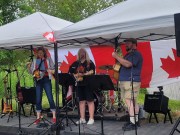By Paul and Debra Harpley
The 35th annual Sutton Christmas Bird Count was held on Tuesday, December 28, with a total of 52 observers tallying 10,295 individual birds of 57 species.
The count area included Georgina, East Gwillimbury, northwest Uxbridge districts, and part of south-east Simcoe County.
In 2020, the Sutton count was condensed to local birders and feeder watchers, as the province’s COVID-19 lockdown restricted inter-regional travel. Still, 50 species were documented on count day
This year’s count day started off fully overcast after 6:30 a.m. for those “owling” with a temperature of -1 degree Celsius.
As the day progressed the temperature rose only slightly to 1 degree by late afternoon. Winds began from the west at 16 km./hour, changing to 24 from north-west at 10 a.m. then dropping to 6 by 4 p.m. from the east.
The cyclonic change in the wind direction throughout the day was unusual in our experience over 34 years from previous count days. The sun only appeared briefly around 1 p.m. Lake Simcoe, and all rivers and streams were fully open of ice, including Cook’s Bay, a rather rare condition from past counts.
A total of 56 species on the day (higher than most years), and 3 bird count week species were recorded.
With only some snow lingering on the ground before the count, and seasonally warm temperature, it was noted by participants that some feeders were slow as birds were dispersed feeding on natural forest/field food.
Highlights and notables for the count day were American Black duck (2), Redhead (2), Red-breasted merganser (1), Hooded merganser (8), Sharp-shinned hawk (1), Cooper’s hawk (2), Northern harrier (3), Merlin (1), Great Black-backed gull (7), Golden-crowned kinglet (1), Brown creeper (2), Horned lark (4), American robin (33), Northern mockingbird (1).
Despite the windy morning, and generally a “slow bird morning” for many species, the early owling experience was great for those out before first light confirming Barred owl (3), and Great Horned Owl (4). Throughout the day Snowy owl (6) were seen and documented.

Higher numbers were recorded for Bufflehead (78) and Common goldeneye (1266) on Lake Simcoe that on most past counts, with no lake ice formation. Bald eagle (17) was the highest number recorded in the 35 years of the count.
Three land birds of interest with high numbers were Black-capped chickadee (391), European starling (3,343) and American Tree sparrow (104).

Our native chickadee is a winter friend to everyone and amazingly despite its small size can withstand our coldest winter weather and thrive, and this year was a high number of them in the forests.
European starlings an introduced species to North America, are derived from two introductions in New York City, 60 birds, 1890, and 40 birds, 1891. They have spread to the Pacific coast and up into central Canada, are an introduced/naturalized species often considered invasive that continues to thrive everywhere including our area.
Tree sparrows this year were easy to find, often at feeders signifying the continuing warm temperatures, whereas on count days of cold weather many of them linger longer and feed here preparing for flying south before the deep winter sets in.
Two bird species expected on count day but not seen, though documented for count week were Ruffed grouse (2) and Pileated woodpecker (1).

A significant surprise was the third count week species, Evening grosbeak (30) in one flock two days before the count, at the feeder of Loes and Hans Pape near Elmgrove.
This event is representative of an echo flight (from 2019/2020 large irruption) of these grosbeaks out of the boreal forest to the south, looking for good quality native spruce and hemlock seed but also raiding feeders particularly with black oil sunflower seed.
Thanks to all field birders and feeder watchers who participated in the count.
- June 24, 2025 Issue - June 26, 2025
- June 10, 2025 Issue - June 15, 2025
- May 24, 2025 Issue - May 25, 2025










































